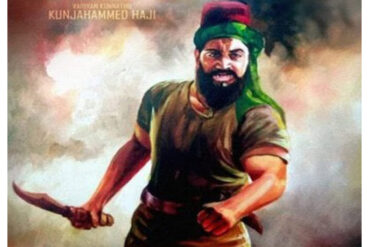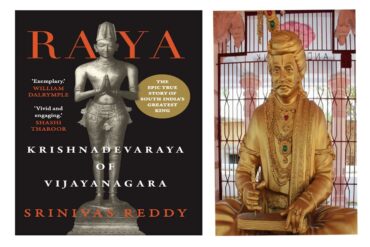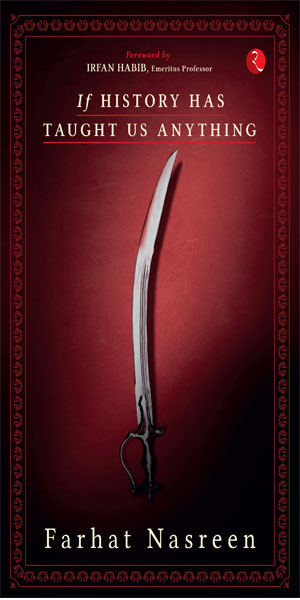Akbar probed into open-mindedness from the very beginning of his career. However, his secular views surfaced clearly sometime around 1580. Thereafter, his acceptance of and respect for other faiths was so unconditional that the voice of orthodoxy, Abdul Qadir Badaoni, and the Christian Jesuits declared that perhaps he was not a Muslim. Shaikh Ahmad Sarhindi went a step further and claimed that Akbar had not only deviated from Islam, but he hated it.
A simple explanation for Akbar’s liberalism is often located in the claim that his mother was a Shia and therefore he was exposed to the idea of balancing differences of creed from early childhood. However, Iqtidar Alam Khan opines that Hamida was not a Shia, since her brother Mu’azzam Beg was involved in the assassination of Humayun’s Shia Wazir Khwaja Sultan Rushdi (1546), and the killing was understood to be the design of orthodox Sunni bigots.
This shifts the focus towards other early influences on the Baadshah’s mind— and in this context the role of his tutors seems noteworthy. Two of them were Irani Shias—Bairam Khan and Mir Abdul Latif Qazvini—and the third was a Sunni Turani, Munim Khan. Luckily, all of them were above sectarian prejudices. In fact, if one digs deeper, beyond the general liberality of Akbar’s immediate ancestors one finds the roots of toleration in the Mongol traditions.
The cultural ethos of the Timurids promoted broad-mindedness. Timur respected all religions and Shias were never persecuted in the Timurid principalities. The Yasa-i Chingezi was literally a guidebook of the Timurids and according to Alauddin ‘Ata Juwaini, it required the ruler ‘to consider all sects as one and not to distinguish them from one another.’ According to Juwaini, Chengiz Khan refrained from bigotry, communal preferences and discriminatory policies. In fact, Iqtidar Alam Khan attributes Akbar’s persecution of the Shias and Mahdavis (1560) to the erosion of the influence of Yasa-i-Chingezi. In the 1560s, the Chishti Khanqahs (hospices) had introduced Akbar to a liberal way of thinking. In addition to his regard for Khwaja Muinuddin Chishti of Ajmer, he was particularly indebted to Shaikh Salim Chishti of Sikri. After the death of many of his newly born children, Akbar left one of his pregnant queens at the Shaikh’s khanqah at Sikri and requested him to pray for the birth and survival of an heir.
The prince born here lived and eventually succeeded Akbar as Jahangir, the fourth Mughal emperor. A massive palace complex and a lofty mosque were built at Sikri as a mark of the Baadshah’s reverence. The Shaikh’s majestic shrine was embellished with the finest marble lattice work possible, and the Buland Darwaza further added to the allure of the place. Akbar lovingly called his son, Shaikhu Baba. His other name was Salim, also after the Shaikh of Sikri, whose prayers were held to be instrumental in the prince’s birth and survival. Shaikh Muhammad Ghaos and his son Shaikh Muhammad Ziyauddin were also consulted by the Baadshah for guidance.
He was introduced to the ideas of Fana (an inexplicable state of existence in nonexistence) and Wahdat ul wujud (unity of existence). In 1573, he regarded Khwaja Muinuddin Chishti as his spiritual preceptor and swore to kill anyone who said that the saint was ‘gumrah’ (misguided/lost). After 1575, he tried to learn the Chilla–i Ma ‘kus (concentrating on God while suspended head down in a well for forty days and nights) from Shaikh Chaya Laddha.
Badaoni reports that the Emperor took interest in learning various spiritual practices. While the Sufis pulled him towards liberality and humanism, Shaikh Mubarak and his sons Faizi and Abul Fazl (the author of the Akbarnama/Ain-i Akbari) assisted the Emperor in the ultimate fine-tuning of his secular inclinations. The idea of justifying taxes as wages of sovereignty, in a manner similar to the European Theory of Social Contract, was a socio-political stance framed by them.
The Mughal theory of kingship thus formulated rested on the belief that if God did not withhold His bounty from anyone, how could the king, who was Zill-i Ilahi—just His shadow—discriminate? Irfan Habib says that there are two variants of Abul Fazl’s theory of state with respect to the patronizing of secular governance and the creation of an intellectually-integrated nobility.
These variants, according to him, can be traced to heterodox tendencies in medieval Islam, prominent among them being Wahdat ul-wajud (Unity of Existence) of Ibn-al ‘Arabi and the Farr-i Izadi (the Divine Light) of Shihab al-Din Suhrawardi Maqtul: the Sun shines for everybody, and that is how the king’s bounty should be—undiscriminating. Iqtidar Alam Khan cites Habib: The influence of the pantheistic sufic doctrine of fana seems to have provided an impetus to Akbar’s interest in philosophy.
In the company of Sheikh Mubarak, Abul Fazl, Ghazi Khan Badakhshi, Hakim Abul Fath, and other rationalist thinkers, during 1578–82, he eventually became familiar with the systematic exposition of the doctrine of wahdat ul–wujud by Ibn al-‘Arabi in a larger philosophical perspective.
As Irfan Habib points out, the pantheism of Ibn al-‘Arabi, despite lacking a rational basis, was capable of becoming a strong ideological challenge to the post-Ghazali conventionalism in Islam. It was this quality of the impact of al-’Arabi’s ideas on Akbar and, more importantly, on his socio-political perceptions during 1578–82, that is characterized by Abul Fazl as the elevation of ‘intellect’ (khirad) to a ‘high pedestal’ (buland paigi).
The idea suggested by Ibn al-‘Arabi that all that is not a part of divine reality is an illusion, in turn, led Akbar to the notion that all religions are either equally true or equally illusory, a suggestion that was bound to be sharply denounced by all shades of orthodox opinion as a deviation from the true path. It was equally unacceptable to the Jesuit fathers then present at the court. Commenting on Akbar’s assurance in 1581 to Jalala Roshani of the freedom to practice his cult, Montserrat observed: ‘the king cared little that in allowing everyone to follow his religion he was in reality violating all.
The Kachwahas of Ajmer had joined Akbar in 1561, and this saw the beginning of liberal policies towards the Rajputs. Chittor fell in 1567 and within three years of that most royal houses of Rajputana, except the Sisodias, joined the Mughal nobility. The following ten years witnessed a rapid and remarkable rise in their power. Akbar’s marriages with the daughters and nieces of the Rajput chieftains influenced him personally.
For example, Abul Fazl reports that both at home and on travels, Akbar drank the water of the Ganges (the river and its water is considered sacred by the Hindus). It was brought for him in sealed jars. Food might have been cooked in rainwater or water from the Yamuna or the Chenab, but a bit of Ganga water was definitely mixed with it. The Abdaar Khana was the department in charge of looking into the water supply for the royal household.
Badaoni, who was dismayed by the Baadshah’s close connection with all religions and specially Hinduism, reports: The Samanas (Buddhist ascetics) and Brahmans brought forward proofs, based on reason and traditional testimony, for the truth of their own… His majesty firmly believed in the truth of the Christian religion, and wishing to spread the doctrines of Jesus ordered Prince Murad to take a few lessons in Christianity under good auspices, and charged Abu-l-Fazl to change the Gospel… Every day he (Akbar) used to put on clothes of that particular colour which accords with that of the regent-planet of the day. He began also, at midnight and early dawn to mutter the spells, which Hindus taught him, for the purpose of subduing the sun to his wishes. He prohibited the slaughter of cows and the eating of their flesh, because the Hindus devoutly worshipped them, and esteemed their dung as pure…
This reason was also assigned, that physicians have represented that the flesh of cows to be productive of sundry kind of illnesses, and to be difficult of digestion. Fire worshippers also came from Nousari in Gujarat, proclaimed the religion of Zardusht as the true one and declared reverence to fire to be superior to every other kind of worship. They also attracted the emperor’s regard, and taught him the peculiar terms, the ordinances, the rites and the ceremonies of the Kaiaanians(an old Persian dynasty). At last he ordered that the sacred fire should be made over to the charge of Abu-l –Fazl, and that after the manner of the kings of Persia, in whose temples blazed perpetual fires, he should take care it was never extinguished night or day, for that it is one of the signs of God, and one light from his lights…
From early youth, in compliment to his wives, the daughters of the Rajahs of Hind, he had within the female apartments continued to offer the hom, which is a ceremony derived from sun-worship… On the festival of the eighth day after the Sun entering the Virgo in this year he came forth to the public-audience chamber with his forehead marked like a Hindu, and he had jewelled strings tied on his wrists by Brahmins, by way of a blessing. The chiefs and the nobles adopted the same practice in imitation of him, and presented on that day pearls and precious stones suitable to their respective wealth and station.
It became the current custom also to wear the rak’hi on the wrist, which means an amulet formed out of twisted linen rags. Every precept which was enjoined by the doctors of other religions he treated as manifest and decisive, in contradiction to this religion of ours (Islam)…
Badaoni writes that Akbar took such interest in understanding Hindu beliefs that priests sat on charpais (cots) which were suspended outside his personal bedchamber, and their discourse went on till late in the night. Badaoni says that the popularity of Hinduism among his subjects made him particularly soft towards it—‘His majesty on hearing further how much the people of the country prized their institutions began to look upon them with affection.’
According to him, the Emperor’s supposed alienation from Muslim orthodoxy stemmed from the irreconcilable differences between the various schools of Islamic jurisprudence. Their refutation of each other led the emperor to doubt all of them. He says that when Akbar came to know of the worthlessness of the theologians of his own time, he inferred the unknown from the known and rejected their predecessors as well. He reports: There he used to spend much time in the Ibadat Khana in the company of learned men and Shaikhs. And specially on Friday nights when he would sit up there the whole night continually occupied in discussing Abdul Qadir Badaoni, Muntakhab-ut Tawarikh, questions of religion, whether fundamental or collateral.
The learned men used to draw the sword of the tongue on the battlefield of mutual contradiction and opposition, and the antagonism of the sects reached such a pitch that they would call one another heretics and fools.
To explain the rise of Abul Fazl in the Mughal court, Badaoni says that the patronization came because in Fazl, Akbar saw someone capable enough to teach a lesson to the Mullas (orthodox Muslim clerics)—whose arrogance, Badaoni mocks, was like that of the Pharaoh (the ruler of Egypt renowned for his relentless pride, who was in conflict with Moses).
In this regard, Shireen Moosvi cites the Muntakhab-ut Tawarikh as follows: …[T]ill one night the vein of the neck of the Ulama of the age swelled up, and there were loud voices and tumult. His majesty got very angry at this behaviour and said to me, ‘in future report any of these people whom you find talking nonsense, and I shall expel him from the assembly.’ I said in low tones to Asaf Khan, ‘If I carried out this order, most of the Ulama would have to be expelled.’ His Majesty asked what I had said. I conveyed to His majesty what I had actually said. He was highly pleased, and mentioned my remark to those sitting near him. He used to summon Makhdumu’l Mulk Maulana Abdullah Sultanpuri to that assembly, in order to annoy him, and would set up to argue against him Hajji Ibrahim and Shaikh Abu’l Fazl, then a new arrival, but now a prime leader of the New Religion and Faith, or rather the Infallible Guide and Representative with full powers with several other new comers.
Abul Fazl records the Baadshah saying that a true mystic guide is the one who recognizes the sorrows and anxieties of his followers and guides them towards a solution, so that they may be relieved of stress. Only maintaining some stereotypical appearance was hardly the signature of a master of spirituality. The lack of Sulh-i kul had caused avoidable disharmony in Hindustan.
In an effort to understand Hinduism and popularize its understanding in the Persian speaking world, Akbar established a Maktab Khana (translation bureau) and ordered the translation of many Sanskrit works. Some examples are the Singhasan Battisi (Namah-i Khirad Afza), Atharva Veda (Atharban), Mahabharata (Razmnama), Ramayana, Harivansha Purana (Haribans), Lilavati (Bhasrakacharya’s work on Arithmetic dated 1150), Tajikanilkanthi (Tajik; a work on astronomy), Rajtarangini (Kalhana’s famous history of Kashmir) and Panchatantra (animal tales with lessons on wisdom).
The Iyar-i Danish was inspired by the Panchatantra and Faizi’s Nal Daman was a retelling of an indigenous tale in Persian. Mirza Abdu’r Rahim Khan-i Khanan (one of Akbar’s closest associates) had commissioned the Persian translation of the Arabic Mirror of Princes, entitled Siraajul Muluk, written by a Spanish author, Abu Bakr Muhammad bin al-Walid Turtushi.
Athar Abbas Rizvi opines that this translation served to encourage the political theorists of Akbar’s times to refer to varied sources, as Turtushi had done. Scholars of Iran, Byzantium, China, Hind and Sind were cited by him. His work drew inspiration from the Kalila wa dimma and refers to Muntakhab al Jawahir (Selected Gems), composed by the Indian Shanaq (Chanakya), as a guide for the monarchs. This text, the Kitaab Shaanaq fi altadbir, was the celebrated Chanakyaniti—a collection of political aphorisms in Sanskrit (not to be confused with the Arthashastra ascribed to Kautilya or Chanakya).
As noted by Irfan Habib, Abul Fazl opined that Indian culture was not studied by the Muslims because there had been no freedom of enquiry under the burden of inherited tradition. ‘The path of asking how and why had been closed.’ During Akbar’s reign, reason was glorified and the doors of questioning and inquiry were reopened. The concluding part of the Ain-i Akbari has a chapter on India’s religions, thoughts and customs. It is remarkable that it rests on the idea of India as a unit of culture of which Muslims were as much a part as were Hindus, Jains and Buddhists. This, Habib emphasizes, is the first explicit and consistent treatment of Indian culture as a composite one. The translation project aimed at lessening the social distances. It was not about power or politics—it was about people.
Excerpted from If History Has Taught Us Anything, published by Rupa, with permission.







